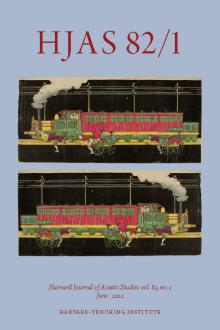June 2022
Steam Engine and Rickshaws [late nineteenth century], woodblock print, ink and color on paper, H 17.0 × W 38.0 cm; Harvard Art Museums/Arthur M. Sackler Museum, Bequest of William S. Lierberman, 2007.214.117. Photo: Imaging Department © President and Fellows of Harvard College.
Editorial Preface
Articles
A Soundscape of Urban Modernity
Voices and Din in 1874 Hanjōki
This article focuses on aural patterns retraceable in four hanjōki (chronicles of prosperity) published in 1874 that deal closely with urban everyday life and constitute a valuable record of life in post-Restoration Tokyo, when things seen and heard in the city began to be treated by writers as indexes of the country’s modernization. Sound representation is a useful tool to investigate multiple layers of meaning within a text, and hanjōki are a perfect example of cultural critique applied to urban environments. Through comparison with the genre’s archetype, Terakado Seiken’s Edo hanjōki (An account of the prosperity of Edo; 1832–1836), I emphasize auditory elements that reveal the authors’ attitudes toward urban life in the 1870s and the complex intertextual system that is an essential feature of the hanjōki corpus. This focus on previously neglected issues encourages alternative understandings of established concepts of disruption and continuity in the modernization process.
本稿では幕末・明治初期の繁昌記に見られる聴覚的描写に焦点を当て、近代移行期の都市に対する四人の作家の観点を考察する。とりわけ江戸・東京の都市空間の音が非常に大きな役割を果す明治7年の繁昌記を分析の対象とし、「近代化」、「都市変貌」の概念を問う。
Publisher at Work
Yu Xiangdou’s Self-Images
The self-images Yu Xiangdou (ca. 1560–1637) inserted in his printed books are often considered portraits of him and thus a proud assertion of his identity as a successful commercial publisher. I analyze his self-images in terms of the highly conventionalized tropes that he appropriated not merely to enhance the market appeal of his imprints but also to prompt readers to visualize his own intellectual labor. By instantiating the otherwise invisible and therefore uncredited intellectual work of publishers, Yu Xiangdou’s self-images served as a link between incorporeal authorship and material proprietorship in the increasingly competitive commercial book market of late imperial China.
余象斗所印書籍中的本人形象並未強調其特殊的個性,而是採用高度格套化的表現形式,是欲增強其印刷品的市場吸引力,亦為促使讀者直觀化其腦力勞動。其畫像在晚期帝國競爭漸盛的商業書市具象化了出版商的腦力勞動,因而連接了物質所有權和無形的著作權。
The Language of Sex in Jin Ping Mei
The sexually explicit contents of Jin Ping Mei have long given the book a notorious reputation. The question remains: What does the novel’s language of sex accomplish in terms of its aesthetics and narrative function? The answer requires considering the artful use of language and imagery and also how the author uses such description to comment on characters and situations. The novel’s sexually explicit scenes can be divided into two modes. In the high-erotic mode, the author exalts sexual acts in euphemistic and figurative language, albeit also often parodic language. In the graphic mode, he describes sex in terms of its raw sights and sounds, its unfiltered excess. Jin Ping Mei inherits the first mode from its past, but the graphic mode is something that came to fruition in the novel’s own Ming era and to which Jin Ping Mei contributed profoundly.
《金瓶梅》的情色描寫向來給它帶來有傷風化的聲名。然而,讀者不應忽略此種描寫在美學與敘述上所起的重要作用。小說中的性描述可分兩種,一為委婉比喻,二為直露狀摹。前者作為傳統由《金瓶梅》承用,後者則是明中晚葉才趨成熟,乃《金瓶梅》對文學史的巨獻。
